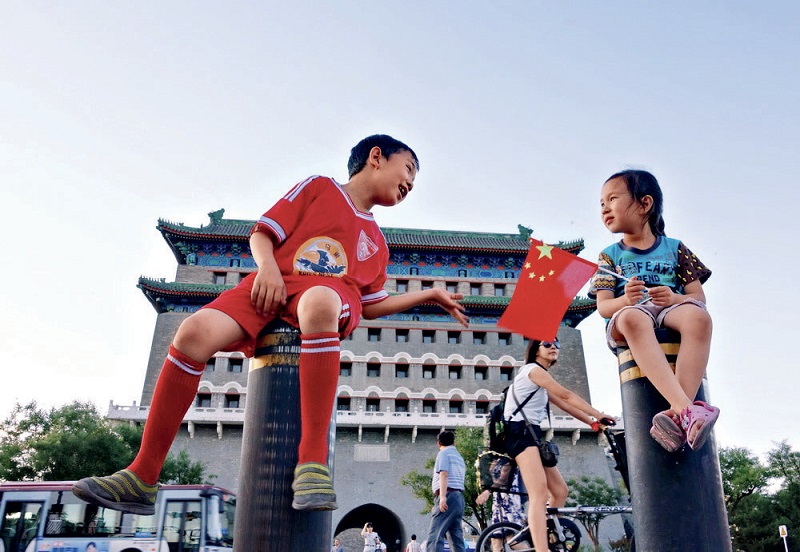— 30 Years of Photographing Hutongs in Beijing

Two young tourists in front of the Arrow Tower in Qianmen, Beijing, on June 7, 2014. Photos by Yu Xiangjun
No one can precisely describe Beijing with a single word or sentence due to its extreme complexity. Every passenger who arrives in Beijing by plane is welcomed by an ocean of light. The light resembles boiling magma, flowing along a layout of the city in an orderly manner. If Chang’an Avenue, Sanlitun, China World Trade Center, and National Olympic Sports Center are highlights of Beijing, the hutongs (lanes) distributed along the Central Axis represent the other side of the capital city. They tell the stories of this city and its citizens with a subtler voice. In these places where the city’s neon lights cannot reach, the essence of the city’s daily life exists in a small restaurant, a tanghulu (a traditional Chinese snack of candied fruit), or even a bowl of fermented soybean drink.

This photo, taken in January 2010, captures a sunset scene on Xicaoshi East Street in Beijing.
I first began intentionally recording hutongs and the Central Axis of Beijing with photos back in 1993. That was still the era of film cameras. One day as I passed the moat of the Forbidden City at dusk, I saw two children in white clothes playing in the twilight, which looked just like a scene in the Japanese movie Muddy River directed by Kohei Oguri. I pressed the shutter to capture the touching moment. Since then, urban memories have been an important subject of my photography. Although many hutongs disappeared during the rapid urbanization and renovation of the old part of the city, some near the Central Axis were still preserved and injected with new vitality under the new urban construction plan. I have been exploring Beijing’s history along the Central Axis, recording its landscapes, and shooting a lot of videos near the main artery of the city.
Due to the fast development of self-media, daily life in hutongs has become some of the best materials for ordinary people to post on social media. Many inhabitants in this city and artistic youth from other places have begun to examine and soak up the unique taste of the ancient capital. With their lenses, they capture the joys and sorrows of the residents in hutongs in different seasons. These quaint alleys host the lives of ordinary people in Beijing while recording the changes in the capital’s history and culture.

A young man in traditional attire in Beijing’s Jingshan Front Street on November 7, 2021.
Over the years, artistic young people have always sought a glimpse of Beijing’s past from images and videos. The city walls of Beijing, unfortunately, were demolished decades ago. When Ling Zifeng directed the film adapted from the novel The Rickshaw Boy by famous Chinese writer Lao She in 1981, scenes involving Beijing’s old city wall were shot in Xi’an, Shaanxi Province, which still had a complete ancient city wall at that time. With the protective restoration of hutongs, many near the Central Axis now shine with original features. People have started to recall lost time from the relatively complete blocks and courtyards. Walking on ginkgo leaves in autumn and white snow in winter takes you back to Beijing of the past when the pace of life was slower — a unique feeling in stark contrast to the busy modern metropolis.
Due to rapid development of the economy, young people’s recreational activities are becoming more and more diversified, and the hutongs are becoming younger and younger. Escaping busy and stressful work, young people are finding hutongs with unique characteristics near the Central Axis good places to spend weekends. Yangmeizhu Byway near Qianmen, for example, is a very dynamic hutong. The once dilapidated houses along the narrow street were transformed into fashionable bars, cafés, and various design shops. The Beijing Design Week was held there in 2015.
In his song named after the Drum Tower (a time-announcing building dating back to 1272) in Beijing, local balladeer Zhao Lei sings: “I am a silent passenger who misses you through the window of the bus. When the No. 107 bus passes again, the bus of time will take away youth.” This song has added a poetic touch to the street passing by the Drum Tower. And when the No. 107 bus crept up slowly, romance in the air spread quietly. Years have passed, and the city has witnessed countless people come and go. No one will be forever young, but young people are eternal, and they are keeping the city young.